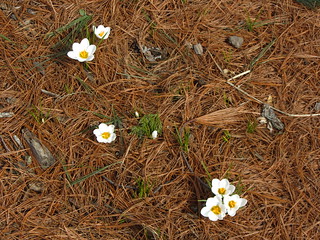
I'm a writer, publishing both as SJ Rozan and, with Carlos Dews, as Sam Cabot. (I'm Sam, he's Cabot.) Here you can find links to my almost-daily blog posts, including the Saturday haiku I've been doing for years. BUT the blog itself has moved to my website. If you go on over there you can subscribe and you'll never miss a post. (Miss a post! A scary thought!) Also, I'll be teaching a writing workshop in Italy this summer -- come join us!
Read/Post Comments (4)

Bird report
Long time since I've given you the Lower Hudson River East Bank Bird Report. It's settled out like this: the geese have spread out, nested, and produced early, though we had some really bad weather just about when those first eggs would have hatched, and so what we have now are two pairs of geese with one gosling each. It's sad, and it's also adorable, these huge geese with this tiny pencil dot paddling in the water behind. The chick follows the female and the male brings up the rear, though one of these pairs has a third adult who also swims with them. Maybe it's one of their chicks from last spring. Or maybe they're kinky.
Meanhwile, the wood ducks and buffleheads, after a few weeks, went on up north. According to my friend Jim, who knows a lot more about birds than I do, they don't stay down here anyway and probably weren't chased away by the geese, no matter what the geese like to think. The mallards -- the Ricardos and Mertzes -- are still around. I don't know where they're nesting but I saw the two males feeding together yesterday, which probably means the females are sitting on eggs and will take their turn feeding when the males come back to take their turn sitting. There's a pair of cormorants, though they don't seem to spend any time together. You'll see one flying over the pier and the other feeding in close to the wall. But they must coordinate somehow. Or maybe not. Maybe female cormorants leave the eggs when they feed and it works for them, and the males just impregnate them and scram. Anyone know?
The best, though, are the ring-necked ducks. There are about 40 of them, in three flocks. One of the flocks hangs around near my new spot by the river. If I get there early enough, they're still asleep. The other day the river was absolutely glass -- no tide, no wind, no movement. The ducks were sleeping, heads under their wings, until the other two flocks came circling in. A couple of sleeping birds woke as they landed, one flock on the north, one on the south. The newly-awake birds swam around waking up everyone else, and then led the local flock to the group on the north. There was a brief standoff, lots of ducks motionless in the water, lots of beaks facing each other. Then the leaders swam into the new flock and the others followed. The two flocks wove through each other for awhile and then, as a single flock, went over and did the same thing with the other new group. Then as one huge flock they all swam north, out of sight.
Meanhwile, the wood ducks and buffleheads, after a few weeks, went on up north. According to my friend Jim, who knows a lot more about birds than I do, they don't stay down here anyway and probably weren't chased away by the geese, no matter what the geese like to think. The mallards -- the Ricardos and Mertzes -- are still around. I don't know where they're nesting but I saw the two males feeding together yesterday, which probably means the females are sitting on eggs and will take their turn feeding when the males come back to take their turn sitting. There's a pair of cormorants, though they don't seem to spend any time together. You'll see one flying over the pier and the other feeding in close to the wall. But they must coordinate somehow. Or maybe not. Maybe female cormorants leave the eggs when they feed and it works for them, and the males just impregnate them and scram. Anyone know?
The best, though, are the ring-necked ducks. There are about 40 of them, in three flocks. One of the flocks hangs around near my new spot by the river. If I get there early enough, they're still asleep. The other day the river was absolutely glass -- no tide, no wind, no movement. The ducks were sleeping, heads under their wings, until the other two flocks came circling in. A couple of sleeping birds woke as they landed, one flock on the north, one on the south. The newly-awake birds swam around waking up everyone else, and then led the local flock to the group on the north. There was a brief standoff, lots of ducks motionless in the water, lots of beaks facing each other. Then the leaders swam into the new flock and the others followed. The two flocks wove through each other for awhile and then, as a single flock, went over and did the same thing with the other new group. Then as one huge flock they all swam north, out of sight.
Read/Post Comments (4)
Previous Entry :: Next Entry
Back to Top